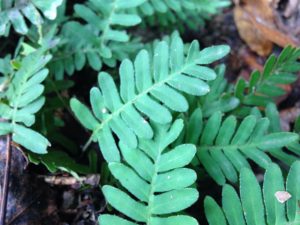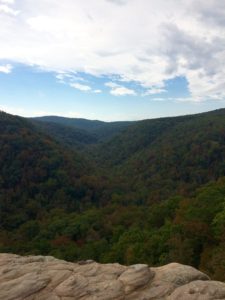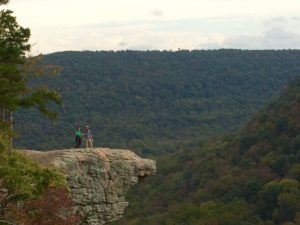On my recent trip through eastern Kansas and the Ozarks, I encountered a plethora of native plant life. I was excited to see some of the woodland species we offer at our plant sale in situ.
My traveling companions may tire of me identifying familiar species, but that doesn’t stop me! Though much of our focus here at the Arboretum is aimed at prairie species, our native woodland landscapes in the far eastern part of the state are just as interesting and diverse. When driving east, those small wooded areas are just the introduction to the vast forests of the Ozarks up ahead.
A Woodland Ecosystem

Photo found at USDA plant database by Thomas G. Barnes, hosted by the USDA-NRCS PLANTS Database / Barnes, T.G., and S.W. Francis. 2004. Wildflowers and ferns of Kentucky. University Press of Kentucky
Woodlands support a very different set of flora and fauna. Birds, deer, and groundhogs are active in these forests, filling their own forest feeding niche. Tall canopy trees, such as maple and oak, provide the shade and protection that all species beneath them require to flourish. While hiking I saw some of my favorite under story trees – pawpaws (Asimina trioloba) along the stream banks at Petit Jean State Park (AR), sassafrass (S. albidium) at Ha Ha Tonka State Park growing in a clearing. Beneath the under story layer creep the shade-loving late-season flowers like woodland aster (Symphyotrichum cordifolius, S. laevis) and certain goldenrods (Solidago caesia, Solidago ulmifolia). I was delighted to see them blooming away, attracting pollinators to take their last gulps of nectar before winter. Ferns were abundant in the lowest areas of the forest where water collects and dew settles – the resurrection fern seen below can bring itself “back to life” after being without water for 100 years!

Resurrection fern or little gray polypody (Pleopeltis polypodioides) – taken near the natural stone bridge at Ha Ha Tonka State Park
Rocks, Crags, “Karst”
Traveling home through forested northern Arkansas and far southeast Kansas instilled new appreciation for the bald, rolling hills of the prairie we encountered closer to home. The steep hills (or mountains, as the natives may call them) and rock formations create a unique, rugged landscape that slowly mellows as you move westward into Kansas. The rocky habitat hosts pines and cedars that seem to grow right out of the solid rock walls. The karst topography of Missouri and Arkansas was fascinating! The lay of the land creates seasonal streams and caverns, even underground lakes. These formations are in part due to the chemical make up of soft and hard of rock which dissolve at different rates over time.

The view from Whitaker’s Point down into Hawksbill Crag near Boxley, Arkansas. It’s an hour hike up to this rock, and so worth it!
Though we may not consider forests symbolic of Kansas imagery, the easternmost part of our state is home to woodland habitats which form a sort of gateway to the Ozarks. I enjoyed my trip and wish I could enjoy shady hikes and rocky crags every weekend. Luckily, we feature many of the woodland species in this blog post at our plant sale – I can plant a woodland garden of my own to enjoy a bit of eastern habitat… without planning another vacation!

